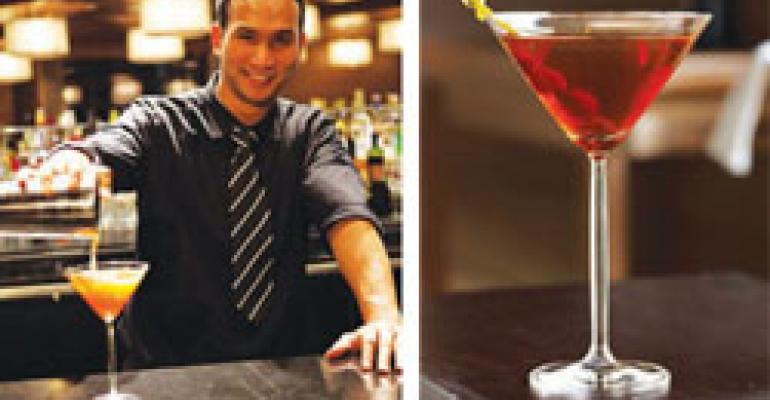Long before vodka, white rum or tequila appeared on these shores, bartenders were creating cocktails with such assertively flavored liquors as rye, bourbon and scotch. The cycle seems to have come full circle.
In a nod to pre-Prohibition days, when whiskey was America’s preeminent spirit, restaurant operators are energizing their bars with whiskey cocktails and promotions. Among the offerings are seasonal signature drinks created with fresh produce from the kitchen, whiskey served in flights and speakeasy-style flasks for sampling, and shots of “moonshine”—raw, unaged whiskey fresh from the still—all intended to showcase a seldom-tasted side of the venerable spirit.
“The big trend in mixology today is to get back to flavor,” says cocktail authority Brian Van Flandern of New York-based Creative Cocktail Consultants. “In the new golden age of the cocktail, which we’re in now, mixologists are seeking original flavor profiles.”
For instance, he sees creative bartenders using Scotland’s briny, peaty Islay malt whiskies as flavor modifiers in drink recipes and dry and spicy American rye whiskeys as versatile cocktail bases.
The Blood & Sand cocktail is a harmonious blend of fruit flavors and scotch notes at Bourbon Steak in Washington, D.C., one of the 15 upscale restaurants in the San Francisco-based Mina Group. Head bartender Kevin Diedrich makes it with Johnnie Walker Black scotch, sweet vermouth, Luxardo maraschino liqueur and fresh orange.
“The scotch is not overbearing, but perfectly balanced with sweetness and cherry and orange flavors,” he says.
Two other Diedrich creations celebrate rhubarb as a fresh spring ingredient. One Time combines rhubarb with Bulleit Bourbon, fresh lime, orgeat syrup, Angostura bitters and ginger beer, while the Alchemist mixes the tart stems with Four Roses Yellow Label bourbon, Combier orange liqueur, fresh lemon, bitters and an egg.
“I think bourbon, and whiskey in general, give great backbone to certain cocktails,” Diedrich says.
Whiskey drinks are prominent on the new Thirst for Action beverage menu of Fox Sports Grill, the six-unit chain of upscale sports restaurants based in Westlake Village, Calif. The Grand Stand Lemonade combines Jack Daniel’s Tennessee whiskey, Amaretto, sweet and sour mix and fresh lemon. The Vegas Bomb consists of Crown Royal Canadian whisky and Peachtree Schnapps dropped into Red Bull.
“Bomb shots are very popular with our demographic and a very unique addition to our beverage menu,” says Mark Bailey, director of ballpark operations.
Creative whiskey applications are at home at Fifth Floor Restaurant & Lounge, a contemporary French fine-dining spot in San Francisco. The Slow Smash is a modified whiskey sour made with Gentleman Jack Tennessee whiskey, unfiltered apple juice, lemon, maple syrup and egg whites.
“It’s a little sweet, so it’s a good choice for someone who likes Cosmopolitans or Lemon Drops,” says assistant general manager Scott Stewart.
The Walnut Grove is made with (ri)1 rye whiskey, Nocino black walnut liqueur, Benedictine liqueur and Regan’s orange bitters.
“It’s patterned after the Manhattan, but a little sweeter and more full bodied,” Stewart says.
In addition, Fifth Floor’s Whiskey Wednesdays promotion offers a different flight of three 1-ounce pours of whiskey for sampling and savoring each week. An example is Plaid & Peaty, a flight of three single malt whiskies from Scotland’s Speyside, Lowlands and Islay regions, priced at $35. In addition, in a playful nod to speakeasy days, the bar offers 200-milliliter flasks of whiskey, which pour about four drinks and are priced from $18 to $60.
“They have a very fun air and a visual appeal,” notes Stewart.
Selling $9 shots of moonshine isn’t going to land the Urban Farmer, a modern steakhouse in Portland, Ore., in trouble.
The “white dog,” or unaged whiskey, is a legal product that a local microdistiller makes from rye and barley in an 80-20 ratio. Although it comes out of the barrel at a heady 120 proof, Urban Farmer’s bar captain, Daniel Stern, prefers it at 98 proof for sipping. He describes it as somewhat rough on the palate, but with lots of spicy and floral notes; customers have likened it to silver tequila or unaged pisco. He is also aging three barrels of it at the bar to see how it evolves in wood.
Above all, the moonshine is a conversation piece and a calling card for whiskey at the Urban Farmer, which is one of seven restaurants operated by Denver-based Sage Restaurant Group.
“One type of person who tries it has an intellectual interest in spirits and distilling,” says Stern. “The other type is someone who sees moonshine and says, ‘Hey, yeehaw.’ And that’s great too because people have fun with that.”




